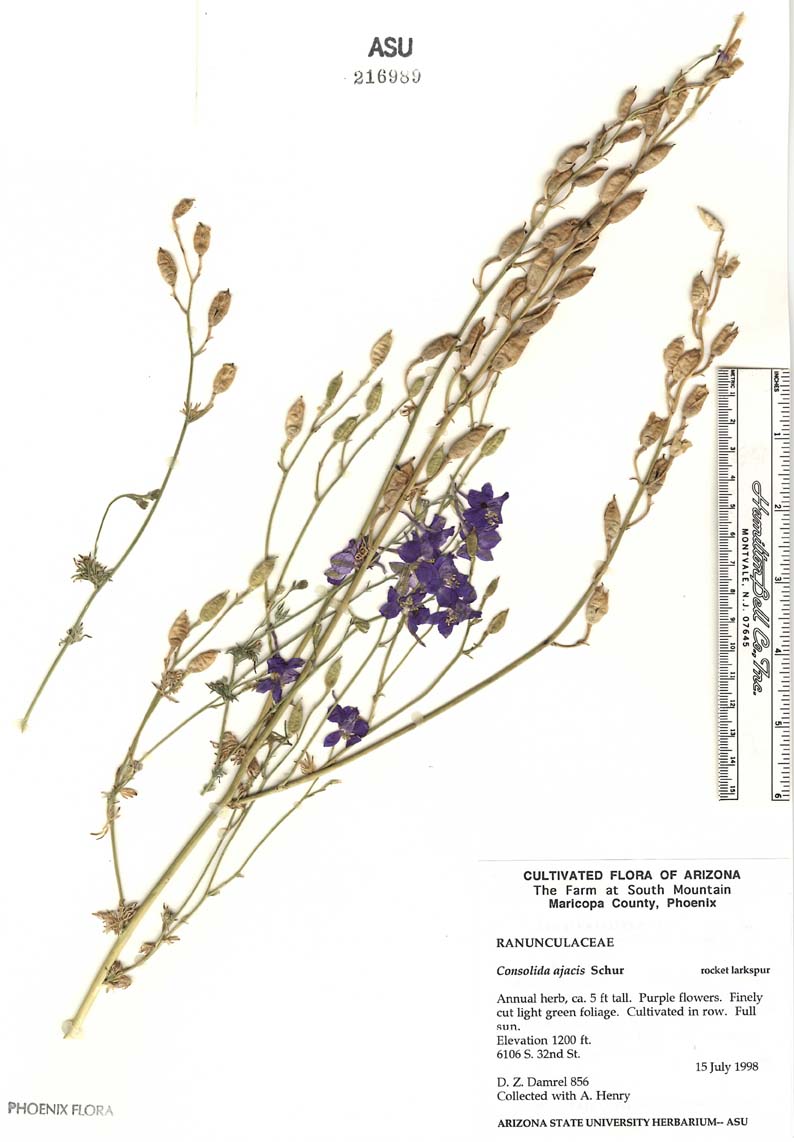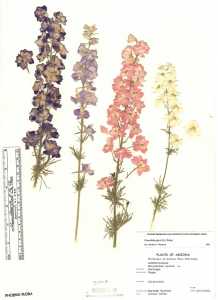|
|
|
|
Family: Ranunculaceae
doubtful knight's-spur
[Consolida ambigua (L.) P. W. Ball & Heywood, moreDelphinium ajacis L., Delphinium ambiguum Loisel.] |
Stems 3-8(-10) dm, glabrous to sparsely puberulent. Leaves 5-20 or more. Leaf blade orbiculate, 12-60-lobed or more, 1-5 cm wide, glabrous to puberulent, lobes less than 1.5 mm wide. Inflorescences 6-30(-75)-flowered, simple or with 3 or fewer branches; bracts (at least lowermost 2) with 5 or more lobes; pedicel ascending-spreading, 1-3(-5) cm, ± puberulent; bracteoles not touching sepals, 4-20mm from flower, ± linear, 1-3mm, ± puberulent. Flowers: sepals blue to purple, rarely pink or white, nearly glabrous, lower sepal 8-18 × 4-8mm, lateral sepals 8-18 × 6-14 mm, spur 12-20 mm; petals of same color as sepals or whiter, lateral lobes 3-6mm, terminal lobes 5-8 × 2-4 mm, sinus 0.2-1 mm. Follicles 12-25 mm, puberulent. Flowering summer. Waste places, old homesites, drainage ditches, roadsides, and railroads; 0-2000 m; introduced; B.C., Man., Ont.; Ala., Ariz., Ark., Calif., Conn., Del., D.C., Fla., Ga., Ill., Ind., Iowa, Kans., Ky., La., Md., Mass., Mich., Minn., Miss., Mo., Mont., Nebr., N.C., N.Dak., N.J., N.Y., Ohio, Okla., Pa., R.I., S.C., Tenn., Tex., Vt., Va., W.Va., Wis.; native to Europe and Africa; introduced in Asia and Australia. In many floras the names Consolida ambigua (Linnaeus) Ball & Heywood and Delphinium ambiguum Linnaeus have been misapplied to this taxon. Consolida ajacis has escaped and become more or less naturalized in many temperate and subtropical parts of the world. It is by far the most commonly encountered species of Consolida in North America. The Cherokee used Consolida ajacis medicinally in infusions to treat heart problems (D. E. Moerman 1986, as Delphinium ajacis ).
General: Introduced annual, 30-100 cm tall; stems erect, simple or branched, the branches ascending, glabrous to sparsely puberulent; taproot slender. Leaves: Cauline, alternate, palmately finely dissected, 1-5 cm wide, with 12-60 linear to filiform segments, these less than 1.5 cm wide, glabrous to puberulent; lower cauline blades petiolate, upper cauline blades sessile. Flowers: Inflorescence a compound cyme of 7-20 flowers, axillary; flowers unisexual (the plants dioecious), radial; sepals wide-spreading, obovate to oblanceolate, 6-10 mm long, white to cream; petals absent; staminodes absent between stamens and sepals; flowers May-September. Fruits: Follicle, 12-25 mm long, pubescent; seeds several. Ecology: Disturbed habitats, roadsides, railroads, ditches, old homesites; 1400-2600 m (4500-8500 ft); Coconino, Gila, Maricopa, and Yavapai counties; widely distributed throughout North America. Notes: This plant species can easily be mistaken for a Delphinium due to its defined sepal spur and divided leaves, but Consolida is an annual with a single pistil and 2 fused petals, whereas Delphinium is a perennial with 3-5 pistils and 4 distinct petals. Editor: Springer et al. 2008 |



